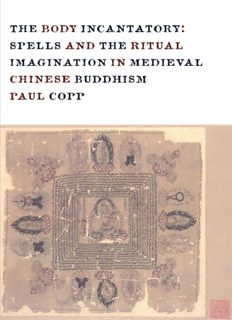
The Body Incantatory: Spells and the Ritual Imagination in Medieval Chinese Buddhism PDF
Preview The Body Incantatory: Spells and the Ritual Imagination in Medieval Chinese Buddhism
THE BODY INCANTATORY THE SHENG YEN SERIES IN CHINESE BUDDHIST STUDIES THE SHENG YEN SERIES IN CHINESE BUDDHIST STUDIES CHÜN-FANG YÜ, SERIES EDITOR Following the endowment of the Sheng Yen Professorship in Chinese Buddhist Studies, the Sheng Yen Education Foundation and the Chung Hua Institute of Buddhist Studies in Taiwan jointly endowed a publication series, the Sheng Yen Series in Chinese Studies, at Columbia University Press. Its purpose is to publish monographs containing new scholarship and English translations of classical texts in Chinese Buddhism. Scholars of Chinese Buddhism have traditionally approached the subject through philology, philosophy, and history. In recent decades, however, they have increasingly adopted an interdisciplinary approach, drawing on anthropology, archaeology, art history, religious studies, and gender studies, among other disciplines. This series aims to provide a home for such pioneering studies in the field of Chinese Buddhism. Michael J. Walsh, Sacred Economies: Buddhist Business and Religiosity in Medieval China Koichi Shinohara, Spells, Images, and Mandalas: Tracing the Evolution of Esoteric Buddhist Rituals Beverley Foulks McGuire, Living Karma: The Religious Practices of Ouyi Zhixu (1599–1655) THE BODY INCANTATORY: SPELLS AND THE RITUAL IMAGINATION IN MEDIEVAL CHINESE BUDDHISM PAUL COPP COLUMBIA UNIVERSITY PRESS NEW YORK COLUMBIA UNIVERSITY PRESS PUBLISHERS SINCE 1893 NEW YORK CHICHESTER, WEST SUSSEX cup.columbia.edu Copyright © 2014 Columbia University Press All rights reserved E-ISBN 978-0-231-53778-0 Library of Congress Cataloging-in-Publication Data Copp, Paul F., 1965-author. The Body incantatory : spells and the ritual imagination in medieval Chinese Buddhism / Paul Copp. pages cm. — (The Sheng Yen series in Chinese Buddhist studies) Includes bibliographical references and index. ISBN 978-0-231-16270-8 (cloth : alk. paper) — ISBN 978-0-231-53778-0 (electronic) 1. Buddhist incantations—History. 2. Buddhism—China—Rituals—History. I. Title. BQ5535.C67 2014 294.3'438—dc23 2013036862 A Columbia University Press E-book. CUP would be pleased to hear about your reading experience with this e-book at cup- [email protected]. Jacket Image: Madame Wei Mahāpratisarā amulet. Eighth century? Yale University Art Gallery (“Tantric Buddhist Charm,” 1955.7.1a). Hobart and Edward Small Moore Memorial Collection, bequest of Mrs. William H. Moore. Ink and colors on silk. 21.5 cm × 21.5 cm. References to websites (URLs) were accurate at the time of writing. Neither the author nor Columbia University Press is responsible for URLs that may have expired or changed since the manuscript was prepared. For Anna If one holds it to be self-evident that man is gratified by his fantasy, then one must consider that his fantasy is not like a painted picture, or a plastic model, but a complicated construction of heterogeneous components: words and images. Then one would not place operations with written and spoken signs in opposition to operations with “mental images” of events. We must plow through the complete language. —LUDWIG WITTGENSTEIN, “Remarks on Frazer’s Golden Bough” I SING the Body electric; The armies of those I love engirth me, and I engirth them; They will not let me off till I go with them, respond to them, And discorrupt them, and charge them full with the charge of the Soul. Was it doubted that those who corrupt their own bodies conceal themselves; And if those who defile the living are as bad as they who defile the dead? And if the body does not do as much as the Soul? And if the body were not the Soul, what is the Soul? … the body itself balks account. —WALT WHITMAN, Leaves of Grass [1881 ed.] CONTENTS List of Illustrations Preface: The Body Incantatory Acknowledgments Abbreviations Introduction: Dhāraṇīs and the Study of Buddhist Spells 1. Scripture, Relic, Talisman, Spell 2. Amulets of the Incantation of Wish Fulfillment 3. Dust, Shadow, and the Incantation of Glory 4. Mystic Store and Wizards’ Basket Coda: Material Incantations and the Study of Medieval Chinese Buddhism Appendix 1. Suiqiu Amulets Discovered in China Appendix 2. Stein no. 4690: Four Spells Notes Glossary Sources Index ILLUSTRATIONS Figure 1.1. Dhāraṇī Talisman [“Talisman of the Pole Star”] Figure 2.1. Drawing of anonymous Tang-era tomb, Sichuan Figure 2.2. Li Zhishun Mahāpratisarā amulet [“Mahapratisara Bodhisattva with text of Da Sui qiu tuoluoni”] Figure 2.3. Madame Wei Mahāpratisarā amulet, eighth century? Figure 2.4. Madame Wei Mahāpratisarā amulet case Figure 2.5. Drawing of silver armlet from Tang-era tomb, Sichuan Figure 2.6. Armlet, Tang dynasty Figure 2.7. Jing Sitai amulet, eighth century? Figure 2.8. Altar Diagram [“Painting”] Figure 2.9. Altar for the recitation of the Zunsheng zhou (Incantation of Glory) [“Painting/Mandala”], tenth century Figure 2.10. Chen Chouding amulet, tenth century? Figure 2.11. Xingsi amulet, tenth century? Figure 2.12. Kashmiri dhāraṇī stamp, seventh–eighth century Figure 2.13. A-luo amulet, Tang dynasty Figure 2.14. Amulet model (unfinished), Tang dynasty? Figure 2.15. Amulet model, Tang dynasty? Figure 2.16. Amitayus amulet, Tang dynasty Figure 2.17. Guanyin icon, 910 CE Figure 2.18. Mañjuśrī icon and liturgy, tenth century? Figure 2.19. Shaozhen amulet, late ninth century? Figure 2.20. Xu Yin amulet, 926–927 CE Figure 2.21. Jiao Tietou [“Iron-head Jiao”] amulet, late eighth century? Figure 2.22. Dasuiqiu bodhisattva from Mogao Cave 148, Dunhuang Figure 3.1. Enchanting a Corpse with the Incantation of Glory, Mogao Cave 217, Dunhuang Figure 3.2. Dhāraṇī pillar, Foguang si, Shanxi, China
Description: